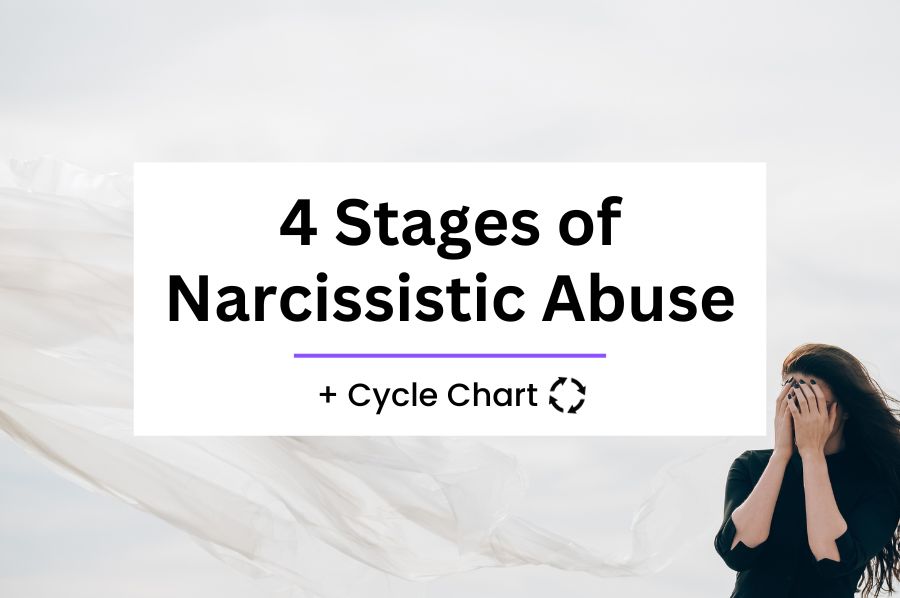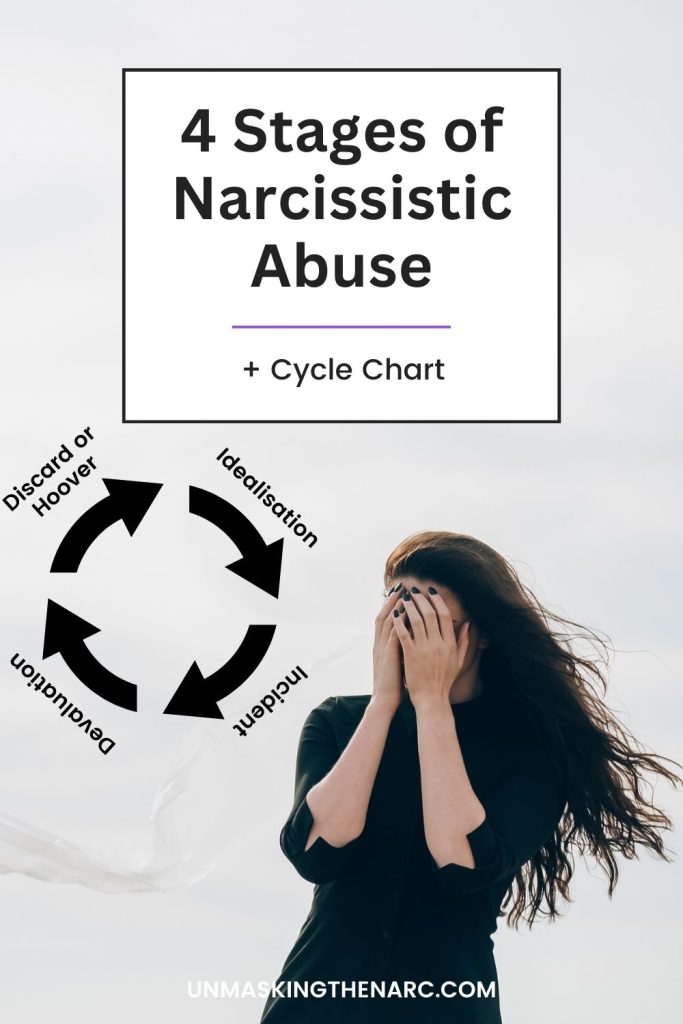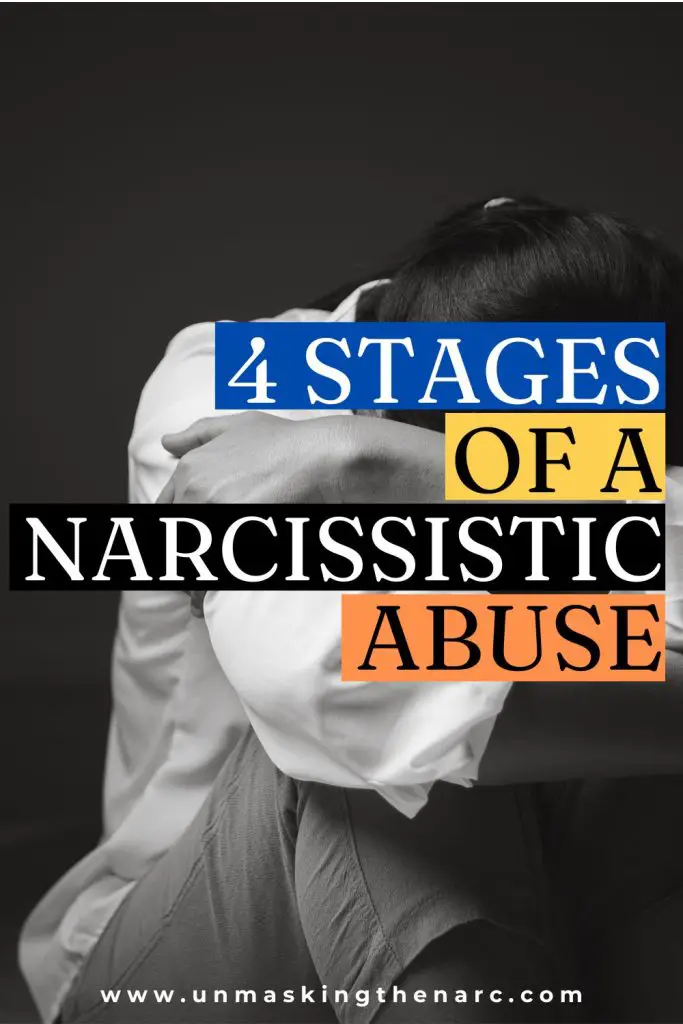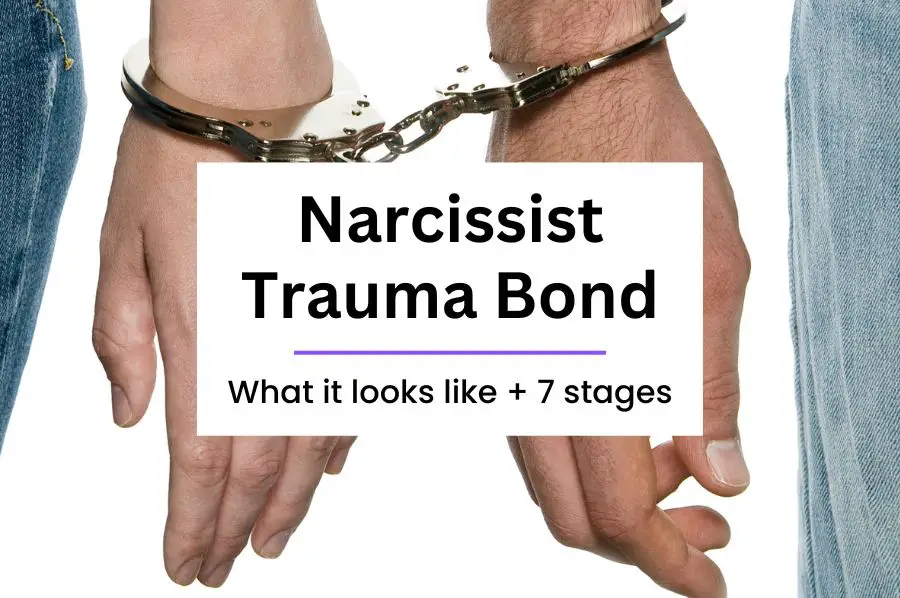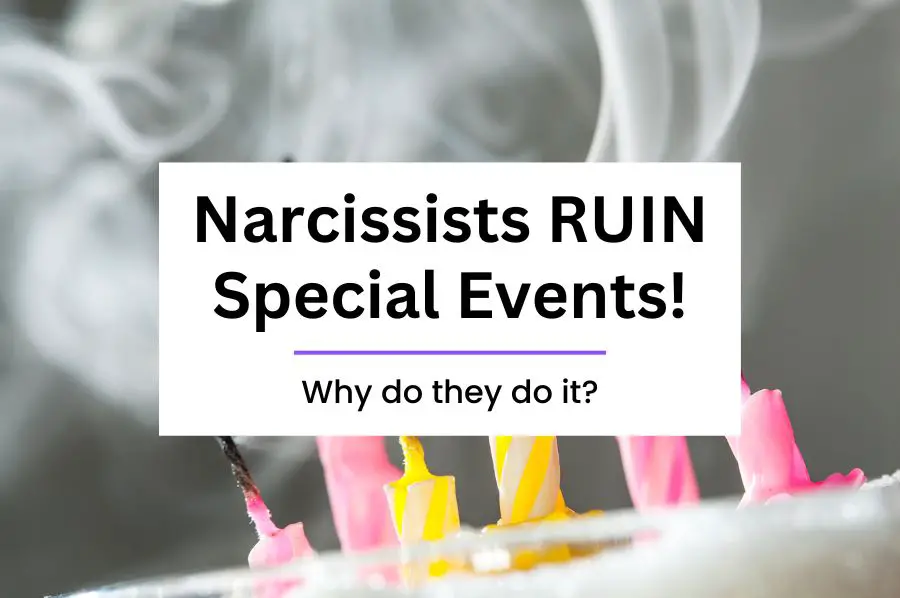The stages of narcissistic abuse can happen in any type of relationship with a narc, whether it be with a parent or caregiver, a coworker or boss, a friend, a sibling or a romantic partner.
Quite often, we aren’t aware that we’re even dealing with a narcissist, because the hot-cold, on-off, in-out dynamics leave us feeling confused as hell.
The word ‘abuse’ in our society is still largely tailored towards physical assault only. However, people are increasingly recognising the damaging trauma that comes from other forms of abuse, such as psychological, mental and emotional.
Thankfully, these days, the term ‘narcissism’ is becoming much more mainstream and understood as being beyond simple vanity. People with high levels of narcissism often go undiagnosed with NPD (Narcissistic Personality Disorder), which is incredibly damaging for those around them.
Having any type of relationship with a narcissist is one heck of a rollercoaster ride – and not a fun one!
Here we take an in-depth look at narcissism, the four stages and the narcissistic abuse cycle chart.
This post contains affiliate links, for more information, see our disclosures here.
What is Narcissism?

Firstly, it’s important to understand how narcissists are created, which will help to give you a clearer understanding of how they operate.
How are Narcissists Created?
No one is born a narcissist. They are created at a young age due to a traumatic experience or set of circumstances.
On a subconscious level, they decided that to survive in this world, they needed to cut off their emotional self, as it was just too painful and made them vulnerable. Spiritually speaking, they killed off their True Self, which only left them with their Ego Self.
Here are the functions of the True Self and Ego Self:
- TRUE SELF – Kindness, empathy, compassion, authenticity, living from truth, direct connection to the divine life force.
- EGO SELF – Materialism, selfishness, greed, criticism, judgement, manipulation, constant need for praise and approval, inflexibility, superiority.
When the narcissist cut off their True Self, they also cut off their ability to feel compassion and empathy towards others, as well as cutting access to their own truth and authenticity.
Being that all they’re left with is the ego, they purely function in life through greed, judgment, manipulation and selfishness. They are not flexible to the needs of others, nor do they care. The idea that they are superior makes them feel as though they’re above all others.
A rather sad aspect of the narcissist is that they will never have the ability to feel love in this lifetime. The ego cannot experience love; only the True Self can.
Please understand that because the narcissist is unable to experience true, unconditional and authentic love within themselves, they do not have the ability to love you or anyone else. That’s why their love is very conditional… because it’s not actually love at all.
The narcissist is now quite an empty vessel who has no way to access the abundance of life force energy from our divine creator (whoever or whatever that is for you).
Now, the only way they can access that life force energy is by stealing it from others. Given that they have cut off all empathy and compassion, they are left with no conscience. They will do whatever they feel they need to do and take whatever they like from others.
Narcissists are energetic vampires.
They’re the infamous “Wolf in Sheep’s Clothing” and “Devil in Disguise.”
Deep inside, the narcissist feels nothing but disdain, shame and self-loathing for themselves. They (their ego) cannot stand to feel such awful, dark shadows, so they spend their lives seeking relief from those inner feelings.
They are much like a drug addict who is constantly on the prowl for their next hit, even though the sense of relief can only ever be temporary.
The energetic relief they pillage is called ‘Narcissistic Supply.’
| READ: Spiritual Aspect of Narcissism → |
What is Narcissistic Supply?

Narcissistic supply is the energy narcissists extract from the world around them. This energy feeds their ego and gives them a satisfying hit, which alleviates their feelings of intense emptiness.
Remember, narcissistic supply provides only temporary relief, so they’ll be back on the prowl for more before you know it.
There is absolutely nothing that can permanently fill the narcissist’s empty void. You cannot fix them.
Trying to save or fix a narcissist will be to the detriment of your own soul. They will simply deplete all of your resources with a smile, then move on to their next victim. They do not have the capacity to feel remorse for the damage they leave behind.
How Do Narcissists Gain Supply?
- Admiration and compliments
- Arguments and creating drama
- Fame and infamy
- Control and manipulation
- Sex
- Having the ‘perfect’ partner and/ or family
- Acquisition of material items
- Appearing successful
- Appearing financially secure
Narcissists do not care if the things they want and demand are only handed over through coercion, as long as they get their way. They do not care that others end up resenting them or that the giving is not genuine.
Since authenticity was cut off within the narcissist years ago, giving and receiving with authenticity mean absolutely nothing to them.
What are the Common Traits of a Narcissist?
Okay, so now that you’ve got some understanding of how narcissists are created and why they need to feed their insatiable egos, let’s look at the common characteristics of a narcissist.
Common Narcissist Traits:
- Self-centredness
- Arrogance
- Lack of empathy
- Excessive need for validation and admiration
- Manipulative
- Will exploit others
- Entitled
- Grandiose sense of superiority
- Envious of others and think others are envious of them
- Fantasies of power and brilliance


The Stages of Narcissistic Abuse
The next piece of the puzzle is the stages of narcissistic abuse.
You will see when looking at the cycle of narcissistic abuse chart below, that this infinite loop will play out over and over again within all of the narcissist’s relationships.
Narcissists will jump from one person to the next, using them up and discarding them like yesterday’s trash, or pulling them back in to repeat the cycle.
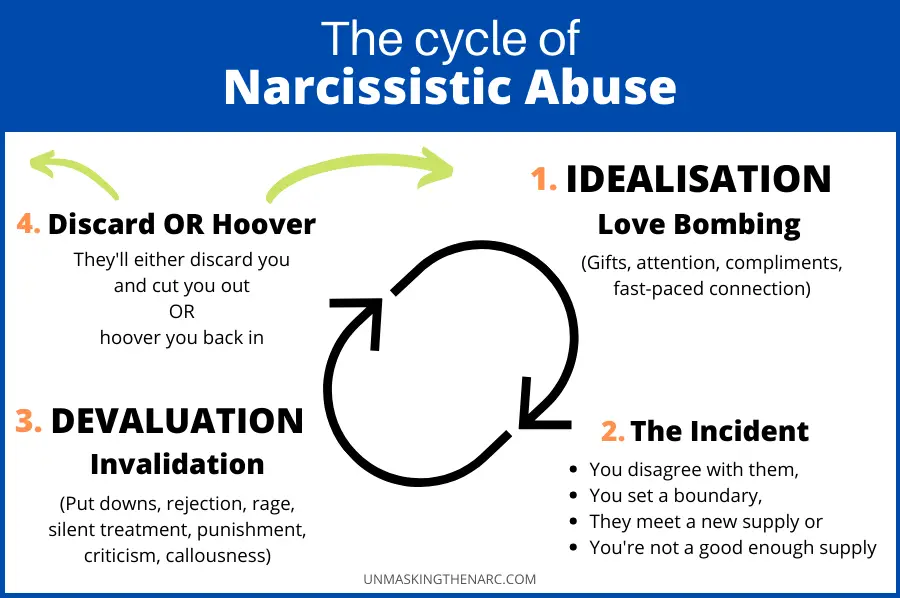
It’s important to understand that narcissists do not view relationships in the same way that healthy people do.
While a healthy person values honesty, teamwork, unconditional love and respect, narcissists only value whatever they can garner for their own selfish needs. The other person is unimportant to them and can easily be swapped out for someone more submissive and obedient at any given time.
By this point, they are a defective human, only seeing life through the lens of ‘survival of the fittest.’ Life is a dog-eat-dog world to a narcissist.
Hence, the way a narcissist approaches relationships is through a state of manipulation, which is identified in the cycle of narcissistic abuse chart above.
The different stages of the narcissistic abuse cycle work with each other to keep you confused and in a push-pull relationship. You’ll find yourself questioning your reality and completely enmeshed in the narcissist’s web. That’s exactly where they want you.
STAGE 1: Idealisation

The idealisation stage of narcissistic abuse is often known as the ‘Love Bombing’ phase. Idealisation occurs at the very beginning of the relationship or friendship with the narcissist.
This is essentially a full-blown honeymoon phase where the narcissist really does think they’ve found the perfect one (supply) and will put you up on a pedestal.
The idealisation phase with a narcissist can be very intoxicating. They can be incredibly generous and attentive. You’ll feel as though this person truly sees you, which will have you opening up and sharing many of your dreams, desires, fears and hopes with the narcissist.
What You May Experience in the Love Bombing Phase:
- Gifts
- Expensive meals and extravagant experiences
- Attention and admiration
- Compliments and flattery
- Sharing stories
- Sympathy
- Promises (aka future faking)
Unbeknownst to you, the narcissist is studying you and encouraging you to share as much information with them as you can.
This is how they learn what your deepest wounds are so that they can use them further down the track to trigger you, gaslight you and invalidate you with those very vulnerabilities.
| READ: 100+ Gaslighting Examples → |
Make no mistake, everything you ever say to a narcissist can and will be used against you in the future.
During the idealisation phase, narcissists will mirror the other person, which is a way of mimicking that they share the same interests, hobbies, beliefs, etc. Mirroring is another way to hook the person in, making them feel like “It’s meant to be,” or “We must be soulmates.”
People are often disappointed down the track when they realise it was all a sham. The narcissist never shared your interests or beliefs at all.
STAGE 2: The Incident

Given that the idealisation phase is often of such high intensity, it makes it an unsustainable place to stay in.
There will inevitably come a time when you disappoint the narcissist or somehow don’t live up to their unrealistic expectations. No one can – it’s impossible because deep down inside, they’re never happy and nothing is ever enough.
The next stage of narcissistic abuse is where an incident occurs, which quite literally changes all of the dynamics with the click of a finger.
You may have some idea of what the incident was, but more often than not, you won’t even know what happened for you to see and feel such a dramatic shift from the narcissist.
Incident Examples:
- You disagree with them
- You set some kind of boundary
- The narcissist gets bored with you
- The narcissist finds a ‘better’ supply
- You start to see through the narcissist’s games
- The narcissist starts resenting all of the nice things they did for you in the love bombing phase
- They feel you slipping away and need to hook you in
- You feel depleted and have nothing left to give
- Things are too peaceful (narcissists need drama to extract supply)
- You trigger a narcissistic injury
Narcissists are incredibly fragile creatures, which is what their mask serves to hide and protect them from the world. They are filled with such deep shame and utterly despise their inner selves, and will stop at nothing to make sure no one can see their truth.
It really doesn’t take much to trigger a narcissistic injury with a narc.
| Narcissistic Injury A narcissistic injury is where a deep emotional wound is triggered within the narcissist, causing extreme devastation to their pride and False Self. Their Ego feels directly attacked, which puts their whole facade at risk of being exposed. As the narcissist refuses to acknowledge their own wounds, they will respond to the attack on their Ego (whether real or perceived) by seeking to punish the person who triggered it in the first place. |
| READ: More Narcissistic Terms → |
A narcissistic injury will cause the narc to immediately react and project all of their pain and shame back onto whoever is around them or whoever caused that trigger to occur.
Since you’ll have no idea what those triggers are, it’s like you’re constantly walking blindly around unknown territory filled with land mines. You have no idea when you’ll step on one, you can’t avoid them forever and when you do hit one, POW! It’s explosive!
Narcissists do not have the ability (or desire) to stop for a minute, self-reflect and look at their own wounds. It’s just too painful for them. They’d much rather spew them onto the outside world than have to be responsible for their own stuff.
Inevitably, the incident leads to the next stage of narcissistic abuse – devaluation.
STAGE 3: Devaluation

By now, you’ve probably picked up what I’m putting down about the fact that narcissists love to punish us mere mortals for questioning their authority and being disobedient subjects.
They are also apt at pulling others down in order to lift themselves up. In other words, damaging the self-esteem of others is a way for them to feel powerful and better about themselves.
The love bombing phase aims to gain your trust, learn what your gaps are (your weaknesses, insecurities, fears and traumas) and lure you into their lair.
Now comes the devaluation stage of narcissistic abuse. This is where lots of red flags start waving, but we often ignore and justify them due to the false image that was portrayed to us in the idealisation phase.
Plus, by this point, we’re usually pretty invested in the friendship or relationship, making it harder to sacrifice what we’ve put in by admitting that there’s something wrong.
Our mind has already been set up to see the narcissist as that generous, charismatic, attentive person, not the cruel, energetic vampire that they truly are. This is known as cognitive dissonance.
| Cognitive Dissonance [noun] Where the mind has two opposing thoughts or beliefs at the same time. It’s essentially a psychological state that keeps you clinging to who you think the narcissist is, rather than who they truly are. On one hand we can recognise on some level that we’re being abused or mistreated, yet we justify (lie) to reason with ourselves as to why the behaviour is happening. • “They’ve just had a bad day.” • “It’s because of their trauma.” • “I have no where else to go, so I need to make this work.” • “Everyone has problems.” • “I can’t leave them, we’re meant to be together” |
Once the friendship or relationship settles into some kind of rhythm, the narcissist will start to devalue the other person. This will often happen in a rather covert manner, which makes it harder to put your finger on. The put-downs can be delivered as ‘jokes’ or sandwiched between ‘kind’ words to disguise their true meaning.
Devaluing also shows up in the narcissist’s actions and how they treat you. Remember, actions speak far louder than words.
Forms of Devaluation:
- Put-downs, insults and criticism
- Gaslighting
- Rejection
- Rage
- Withdrawing affection, emotional and physical intimacy
- Ghosting, disappearing and silent treatment
- Projecting blame onto others
- Disrespecting others and their belongings
- Lying and manipulating
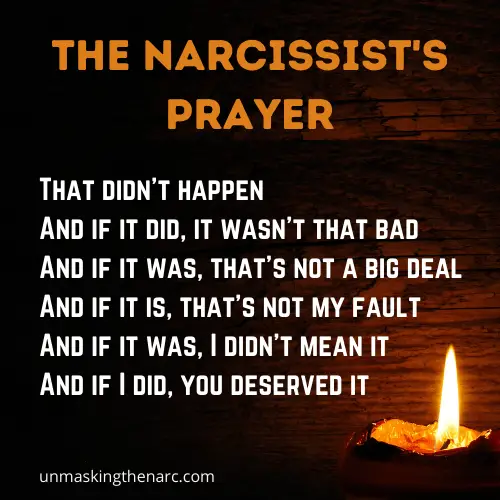
Why Does the Narcissist Devalue?
The narcissist is fully owned by their ego, which survives by projecting any inner hurts and wounds straight onto the outer world. The ego will not meet itself. It has no interest in recognising its traumas and taking responsibility to heal those wounds.
Words of the ego…
- “You need to take away my hurts.”
- “You must obey my every whim.”
- “You must fill my empty void.”
- “You are required to fulfil my unrealistic expectations.”
- “… and If you fail, I will punish you.”
However since these wounds still exist and constantly torment the narcissist, they project their wounds onto you as though they are your wounds instead of theirs.
Then… the narcissist tries to kill those very wounds, which you are now wearing, which is why you end up being fired upon. The narcissist lives in such a delusion that they genuinely believe you are the one doing all of the things they’re projecting onto you, which they then accuse you of.
It’s sick and twisted, which is why high narcissism is considered to be a personality disorder. This goes way beyond someone who tells a few white lies. To the narcissist, their insanity is a complete reality… they have no idea that they have a mental disorder.
| READ: 70+ Things Narcissists Say → |
STAGE 4 (part 1): Discard

The next stage of narcissistic abuse is the discard phase.
You see, given that narcissists have no empathy or compassion, they do not view other human beings in a healthy way. To them, people are merely objects to be used up and tossed aside when they’re done.
I know it’s incredibly hurtful and hard to believe that someone who said they cared for you could see you that way, especially since they seemed to show love and kindness at different times along the way.
It’s only natural to take it personally and feel as though it’s your fault or that you must have done something wrong to invoke such harsh behaviour in someone.
In actuality, the narcissist’s discard has nothing to do with you and everything to do with them.
You see, you were only ever pulled into their inner sphere to serve them and feed them narcissistic supply. It’s as simple as that.
Narcissists expect the world to perceive them as fantastic creatures, and they genuinely think that they are, so in their mind, you should be so lucky to have had that time with them!
Once you are no longer serving them in the way you’re expected to, they’ll discard you in place of someone else who’s fully topped up and not yet depleted. It’s no different to swapping out flat batteries for new ones.
Narcissists see people as items, not independent, living, breathing beings of their own.
Remembering that narcissists see themselves as perfect and don’t ever take responsibility for anything, they won’t even see that the discard has anything to do with them. So, just to rub salt into the wound, not only are they throwing you into the trash… it’s your own fault that it’s happening. You are to blame for things not working out or ending badly; it’s never their fault.
How a Narcissist May Discard You:
- Ghost you, ignore you or just walk out
- Pick a fight then blame you
- Rub their new supply in your face
- Start a smear campaign about you
- Publicly humiliate you
- Become aggressive (physically, verbally, mentally, emotionally)
- Bleed you dry financially and emotionally
STAGE 4 (part 2): Hoover

The final phase that the narc may or may not use in their insidious cycle of narcissistic abuse is the hoover.
If you look at the cycle of narcissistic abuse chart, you’ll notice that the final phase can be either a discard or a hoover, depending on if the narcissist still thinks they can squeeze any more supply out of you.
Ultimately, once a narcissist has used a toy, they see it as being theirs forever, even if it has been all used up and thrown back onto the shelf.
Sometimes, a narcissist will give people the final discard, and that’s that. But more often than not, they will try and hoover many of their old connections back in at some point. If they see that you can fulfil their needs in any way, they’ll want you on the hook, ready to go at a moment’s notice.
If you’re in a relationship with a narc, after they’ve idealised you, abused you, and then discarded you, they will hoover you back in right when they feel you slipping away.
That’s when the stages of narcissistic abuse start all over again, and the trauma bond ends up strengthening over time (more on trauma bonds below).
Another thing to note is that in the narcissist’s mind, if you let them back into your world after they’ve abused you, then you are effectively okaying all of their previous toxic behaviour. You cannot bring it up again, and you can be sure that the abuse will come harder and faster each time as they break down more of your boundaries.
I can look back on my twenty-year relationship with my covert narcissist ex and see the cycle of him pushing me right to the edge, where I was so broken… then he’d pull me back in again. Things would be okay for a bit (a few days, maybe a few weeks), then it would go straight back to ‘normal.’
How Does a Narcissist Hoover You Back In?
The narcissist likes to have multiple sources of backup supply on hand at any given time. They are notorious for staying in touch with exes, whom they see as potential backup plans.
Narcs like to keep many people around for multiple reasons. They may need to borrow some money or have a couch to crash on, or they might need someone to offload their problems onto so that they can garner some narcissistic supply.
Ultimately, the narcissist knows you extremely well by this point, and they will know exactly which manipulations will work best on you. The first angle is to pull at your heartstrings and use your empathy and compassion to guilt you back in. The second tactic is to bully you back in through fear, gaslighting and devaluations.
Examples of how narcissists hoover people back In:
- Reach out unexpectedly
- Seem to be remorseful
- Offer false promises
- Pretend like nothing has happened
- Use an important date as an excuse to contact you
- Offer gifts or money
- Profess their undying love (although they didn’t do it when you were together)
- Play the victim
- Trigger you through other people
- Start love bombing you again
- Need your urgent help
- Accuse you of something to ignite a reaction
| READ: More Hoovering Tactics → |
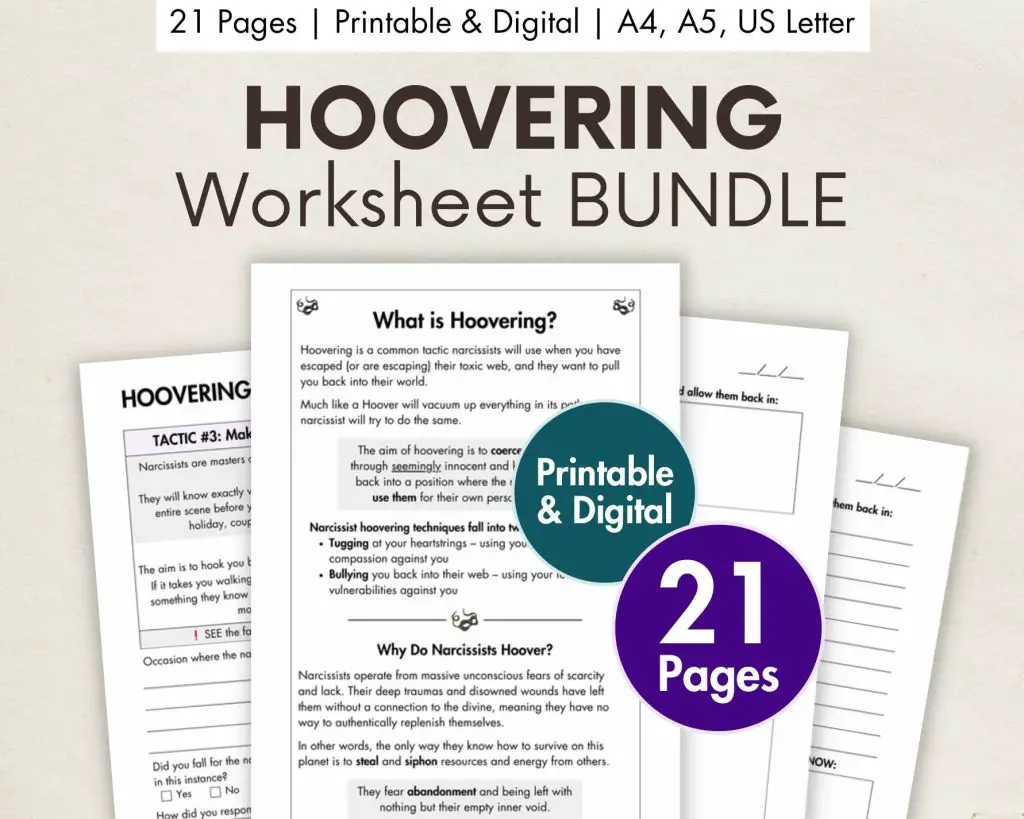
Hoovering
Worksheets & Journal
Never fall for the narcissist’s manipulative hoovers again!
- Hoovering Explained
- 12 Worksheets
- 6 Journal Pages
- 2 Notes Pages
- PRINTABLE & DIGITAL
The Trauma Bond

When a narcissist repeats the stages of abuse with someone over and over again, a trauma bond is formed. As time goes on, the victim becomes so accustomed to the toxic behaviour that it all feels normal.
This is typically why people from the outside may look in and think, “Why do they stay with them?”
| Trauma Bond An emotional bond that is formed between an abuser and their victim. It happens through the recurring cycle of abuse, devaluation and positive reinforcement (i.e. intermittent punishments and rewards). The victim feels bonded to the person who’s destroying them. |
The narcissist basically alternates abusive behaviours with positive experiences. When the abuser can punish you and then subsequently give you the reward you need to feel relief from their abuse, the bond between the abuser and victim deepens.
You end up looking to them for the love and validation you’re so desperately craving, even though they are the very person who are taking those things away from you.
When the narcissist withholds their love, affection, time or energy from you, they are punishing you. When they subsequently give you a little bit back, you feel such relief that everything’s okay again, your body actually mistakes the feeling of ‘relief’ for ‘love.’
You become chemically addicted to the highs and lows of the abuse.
Over time, the pieces they breadcrumb back to you get smaller and smaller, so that what you end up needing to feel ‘okay’ is so small, it’s heartbreaking.
The trauma-bonded person ends up feeling a ridiculous loyalty to the very person who keeps hurting them. This bond causes them to feel stuck and unable to move or free themselves from the narcissist and the abuse. In fact, it’s hard for them to even recognise they’re being abused at all.

Breaking Free From the Cycle of Narcissistic Abuse

Understanding that narcissists are master manipulators who know all of your deepest fears and insecurities, they do not make the ‘Exit’ obvious or accessible in any way, shape or form.
The first step in breaking free from the cycle of narcissistic abuse is recognising and admitting to yourself that the relationship or friendship is toxic. I completely understand that this is so incredibly difficult. I was stuck in the cycle for two decades before being able to get myself out!
Once you recognise that you need to exit, it’s important to have a plan and some support if possible. If you’re in a relationship with a narcissist and you plan on discarding them, be prepared to see the monster that they truly are.
Have separate money to get a new life started, and have somewhere you can move to or stay once you walk out that door.
Once you’ve physically removed yourself from the narcissist, you will have some serious healing to do.
Realising exactly what and who you were dealing with is an incredible blow! You thought they were someone who genuinely loved or cared for you, but now you’ve learnt that that person doesn’t have the capacity to love.
You thought you’d build a life together, but now you realise that the only thing the narcissist was planning was to suck you dry energetically.
No Contact
If you can go No Contact with the narcissist, I highly recommend that this be your priority. No contact is just as it sounds. You do not contact the narcissist at all, and you do not accept any contact from them.
It may be hard at first, especially if the narc tries to shoulder their way through your new boundary. They do not like boundaries, and they will certainly not be expecting one from you.
But hold the line and stick to your guns. Eventually, the narc will get bored of you and need to start searching elsewhere for another supply, if they don’t already have one.
| READ: 23 Expectations with No Contact → |
Low Contact
If you have children, property or business together, you may not be able to go No Contact. In this case, I recommend going Low Contact with the narcissist.
This is where you keep the contact to an absolute bare minimum, and I highly recommend keeping it to emails or messages.
Phone calls don’t keep a written record if you need to draw on that. Also, the narc will use those verbal conversations to draw you into their confusing word salad, throw you off guard and gather information on you.
Keep all communication to the necessary facts and do not deviate from that. The narcissist will no doubt try and get you caught up in general chit-chat (pretending to be the ‘nice guy/ girl’) or throw accusations at you. Do not bite, just stick to the barest of facts, and that’s it.
Set Your Boundaries
If the narcissist in your life is not someone you can easily just walk away from, that’s okay, I get it. Sometimes narcissism can show up in family members, coworkers and mutual friendships, which can make things very difficult.
You need to figure out what your ‘deal breaker’ boundaries are and let the narcissist know what you will no longer tolerate.
The boundary may be, “If you continue to put me down, I will leave, and we’ll have to continue this discussion another time.” Then, when the narc invalidates you (and they will), walk out or put down the phone, so that you’re following through with your firm boundary.
If you stand strong within yourself, it won’t take long for the narcissist to learn that you mean business, and you will no longer be treated like their trash.
Going ‘Grey Rock’ is another useful tactic if you need to still see the narc from time to time. Grey rocking means being as boring and bland as you can (much like a grey rock). That way, the narcissist will get bored of you and move on to someone else.
Heal Yourself and Be Free

The only true way to put an end to being narcissistically abused by anyone ever again is to heal your inner wounds.
Unless you’re working on healing yourself, you will continue to search outside of yourself for love, validation and security. Those are the very things that narcissistic people will exploit so that they can, in turn, use you as a source of energetic supply.
The only way that I’ve found to heal successfully, through my journey, is via energetic healing with Selena Hill. As a spiritual medium, she can access healing and information far beyond what I could ever access in this lifetime.
Honestly, I’ve tried talking it out and reliving the abuse, I’ve tried dealing with it on my own, and I’ve tried researching the heck out of narcissism to try and heal my deep trauma. None of that worked. In fact, my PTSD was getting worse by the day, and panic attacks were starting to creep in and totally derail me.
I was desperate and knew I had to try something, which is when I followed the word-of-mouth recommendation and made a booking with Selena (an energy healer). Through her, the deep wounding that was stuck inside of me was able to be released. The process is much quicker than traditional therapy, and I saw massive shifts after every single session.
If that doesn’t sound like your thing, then find a good therapist who’s well-versed in narcissism and make regular sessions a priority for your healing.
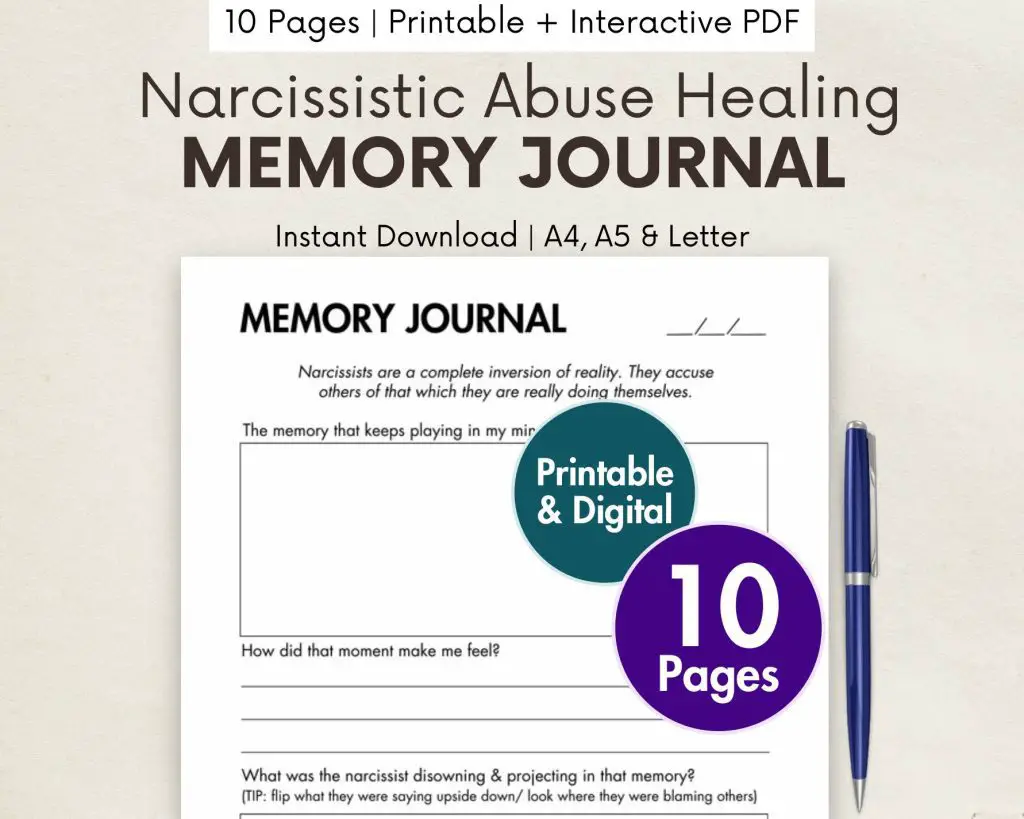
Memory Journal
Release the painful memories once and for all!
- Journal recurring thoughts
- Sort through what’s yours vs. theirs
- Identify your inner wounds to heal
- Return the narcissist’s disowned wounding
- Step-by-step guidance
- PRINTABLE & DIGITAL

